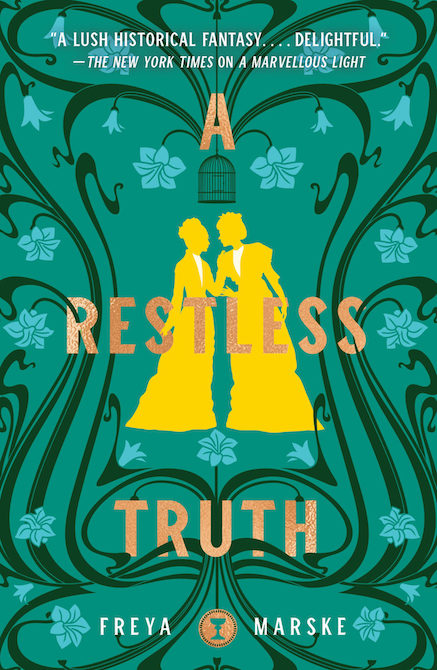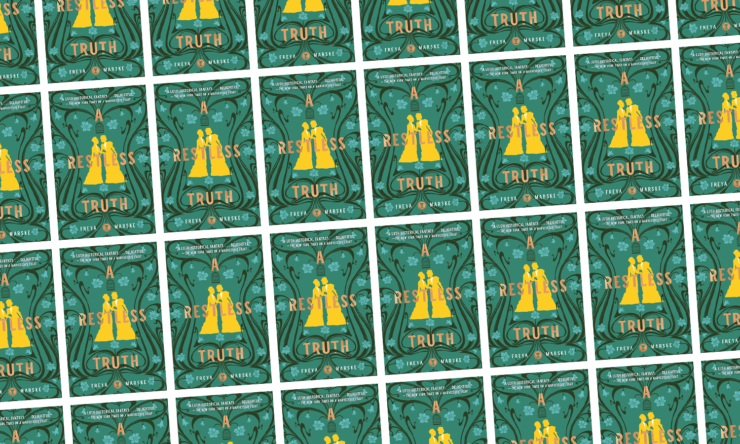There’s a phenomenon whereby sometimes multiple pieces of media will pop up at almost the same moment with almost the same premise. Your Antz and A Bug’s Life. Your The Prestige and The Illusionist. Those two casual sex rom-coms in which Mila Kunis and Ashton Kutcher, confusingly, are not costars. Usually when this happens, you’re just like “Huh.” But if you happen to be a person who really digs historical magicians or animated insects, it’s like Christmas coming twice.
That is how I feel about what I’m calling a spate (it is two) of murder mysteries set on board a ship that also—unfortunately for the murderer—contains a relentlessly determined queer detective. The second one of these will be the second Knives Out movie, whose title I refuse to learn, and the first, of course, is Freya Marske’s A Restless Truth.
Marske’s sophomore novel continues the story begun in A Marvellous Light, which saw Robin Blyth and Edwin Whatsit boning in libraries and uncovering a conspiracy by a bunch of rich jerks to co-opt all the magic in England for their own devices. In the second book, Robin’s sister Maud and a scandalous heiress called Violet bone in ship cabins and carry on hunting for conspiracy McGuffins and the murderers who will stop at nothing to acquire them. Maud came aboard with the intention of seeing the elderly Elizabeth Lazenby safely to England. Instead, Mrs. Lazenby is murdered on the first day out of port, and it’s up to Maud—unmagical and alone—to ensure that the killers don’t get their hands on the magical silver object Mrs Lazenby died to protect. Which Maud has never seen. Which makes securing and protecting it pretty difficult.
Buy the Book


A Restless Truth
I do not subscribe to any birth-order-based psychological theories, but even so I feel that Marske has channeled the muse of younger siblinghood in Maud. Striking out on her own for the first time, Maud is determined not to botch the one true responsibility her brother Robin has ever entrusted her with. She copes with Mrs. Lazenby being murdered by press-ganging a motley group of strangers into an ad hoc, surrogate, murderer-hunting family. I cannot overstate how true to life this is. Younger siblings have a near-supernatural knack for finding people with older-sibling vibes to take care of them while also consenting to be bossed around. (I am both an older and a younger sibling, and therefore nobody can fuss at me for this take, which is factually true.)
Maud’s collection of allies includes the aforementioned Violet, a former burlesque dancer who has just come into money; former magician Lord Hawthorn, who was an absolute asshole in the previous book, but in like a sexy romance hero kind of way; and a journalist called Ross, who has some Intense Eyebrow Interactions with Lord Hawthorn that led me to certain conclusions about book three. By contrast to the first book, which was just Edwin and Robin against the world, A Restless Truth gives us a proper, classic team-up, complete with getting the band together through kidnapping and bribery. It’s Maud’s agenda and Maud’s principles that drive the whole thing—she’s not willing to be dishonest out of fear that she’ll turn to the glittering, callous dishonesty of her parents—and you get the sense that everyone else just sticks around out of morbid curiosity for what Maud’s going to do next.
Where Maud’s an open book, Violet Debenham has taught herself to hold her cards close to the chest. People who know you are people who can hurt you, and she’s much better at putting on her persona of sparkling charm, keeping everyone at a distance by withholding the truth of herself. She can’t quite admit it to herself—at least not at first—but she’s frightened of Maud, who goes through the world like a hurricane being exactly who she is and openly pursuing exactly what she wants. When Maud, very sweetly and forthrightly, propositions her, Violet’s attracted but not prepared to risk herself and her walls for a girl she hardly knows, no matter how pretty she is or how much pornography she’s been reading aloud to her team.
In my personal life I am not a fan of chaos, which frays my nerves and leads to me unknowingly swimming 1.5 laps at the YMCA with my new cell phone in the pocket of my swim dress. In fiction, a spot of chaos can be just the thing to tip characters out of their comfortably accepted daily lives and shake new experiences, feelings, and desires out of them. Maud has never had sex and Violet has never had intimacy, and neither of them felt those things as particular lacks until they are on a boat with murderers and tigers and pornography and nobody can leave. The chaos of the murder investigation has already pushed them both out of their usual social circles and miles out of their comfort zones. Not only are they thrown in with people they wouldn’t have spent time with in the real world, very much including each other, but they’re in a constant state of heightened emotion, murderers are after them pretty frequently, and they do end up with really just an absolute truckload of pornography. Small wonder Violet lets her guard down; small wonder Maud begins to contemplate what it would be like to kiss a girl and like it.
Despite its claustrophobic setting (I love it, I’m obsessed with it, every murder mystery should take place on a boat), A Restless Truth smoothly expands the world Marske established in A Marvellous Light. Marske’s efforts to navigate the perennial challenge of writing historical fiction while white are not vastly more graceful than in the prior book, but we continue to catch tantalizing glimpses of worlds beyond the white upper class our protagonists inhabit. Violet’s magic use is inflected by her time among lower-class theaters in America, and the investigation of the mystery requires our heroes to navigate the thorny class divides of nineteenth-century England, as they try to access areas of the ship that are physically barred to them as well-born women.
Marske retains her knack for conveying a wealth of information about characters and moments through a perfectly evocative detail: Possessed by a ghost, Maud holds herself “like a person who’d tripped on a cobblestone and righted themselves again, but for a few more minutes would be inhabiting the startled vision of themselves sprawled in the gutter.” At another point, Ross’s accent becomes “rougher…as if coming up against Hawthorn’s cut-glass aristocracy had bounced him reactively a few rungs down the ladder.”
Personal preferences aside—I like Violet and Maud better than Robin and Edwin, because I like angst better than fluff, and I like spiky women particularly—A Restless Truth is a tighter, more assured book than its predecessor. Plot points and magical rules from the prior book are concisely and unfussily explained for the forgetful reader (it’s me, I am that reader, because see above wherein everything is chaos and especially the US midterm elections). The emotional and logistical challenges that stand in the way of Maud and Violet’s HEA are sharp and specific, and tightly linked to the unraveling of the central mystery. Insightful, funny, and unexpected, A Restless Truth is a stellar successor that ably continues the mystery begun in A Marvellous Light and leaves the reader eager for the series conclusion.
A Restless Truth is available from Tordotcom Publishing
Read an excerpt here.










